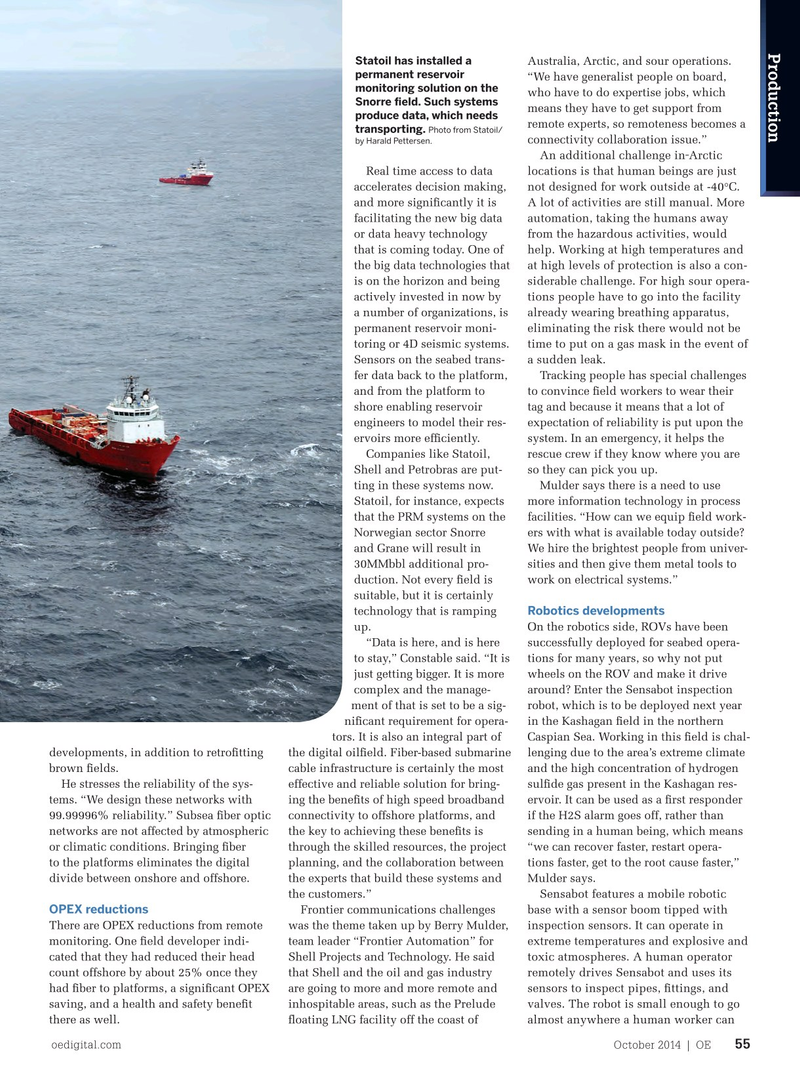
Page 53: of Offshore Engineer Magazine (Oct/Nov 2014)
Read this page in Pdf, Flash or Html5 edition of Oct/Nov 2014 Offshore Engineer Magazine
EyebrowProduction
Statoil has installed a
Australia, Arctic, and sour operations. permanent reservoir “We have generalist people on board, monitoring solution on the who have to do expertise jobs, which
Snorre feld. Such systems means they have to get support from produce data, which needs remote experts, so remoteness becomes a transporting. Photo from Statoil/ connectivity collaboration issue.” by Harald Pettersen.
An additional challenge in Arctic
Real time access to data locations is that human beings are just accelerates decision making, not designed for work outside at -40°C. and more signifcantly it is A lot of activities are still manual. More facilitating the new big data automation, taking the humans away or data heavy technology from the hazardous activities, would that is coming today. One of help. Working at high temperatures and the big data technologies that at high levels of protection is also a con- is on the horizon and being siderable challenge. For high sour opera- actively invested in now by tions people have to go into the facility a number of organizations, is already wearing breathing apparatus, permanent reservoir moni- eliminating the risk there would not be toring or 4D seismic systems. time to put on a gas mask in the event of
Sensors on the seabed trans- a sudden leak. fer data back to the platform, Tracking people has special challenges and from the platform to to convince feld workers to wear their shore enabling reservoir tag and because it means that a lot of engineers to model their res- expectation of reliability is put upon the ervoirs more effciently. system. In an emergency, it helps the
Companies like Statoil, rescue crew if they know where you are
Shell and Petrobras are put- so they can pick you up. ting in these systems now. Mulder says there is a need to use
Statoil, for instance, expects more information technology in process that the PRM systems on the facilities. “How can we equip feld work-
Norwegian sector Snorre ers with what is available today outside? and Grane will result in We hire the brightest people from univer- 30MMbbl additional pro- sities and then give them metal tools to duction. Not every feld is work on electrical systems.” suitable, but it is certainly
Robotics developments technology that is ramping up. On the robotics side, ROVs have been “Data is here, and is here successfully deployed for seabed opera- to stay,” Constable said. “It is tions for many years, so why not put just getting bigger. It is more wheels on the ROV and make it drive complex and the manage- around? Enter the Sensabot inspection ment of that is set to be a sig- robot, which is to be deployed next year nifcant requirement for opera- in the Kashagan feld in the northern tors. It is also an integral part of Caspian Sea. Working in this feld is chal- portion of this data is getting stranded developments, in addition to retroftting the digital oilfeld. Fiber-based submarine lenging due to the area’s extreme climate in the feld and not getting distributed brown felds. cable infrastructure is certainly the most and the high concentration of hydrogen effectively back to the shore. This is the He stresses the reliability of the sys- effective and reliable solution for bring- sulfde gas present in the Kashagan res- critical infrastructure gap that subsea tems. “We design these networks with ing the benefts of high speed broadband ervoir. It can be used as a frst responder fber optic cables that connect to offshore 99.99996% reliability.” Subsea fber optic connectivity to offshore platforms, and if the H2S alarm goes off, rather than platforms eliminates. networks are not affected by atmospheric the key to achieving these benefts is sending in a human being, which means “Broadband data communications or climatic conditions. Bringing fber through the skilled resources, the project “we can recover faster, restart opera- is rapidly emerging as the single most to the platforms eliminates the digital planning, and the collaboration between tions faster, get to the root cause faster,” reliable technology to support the digital divide between onshore and offshore. the experts that build these systems and Mulder says.
felds of today and certainly of the the customers.” Sensabot features a mobile robotic
OPEX reductions future,” Constable says. The drivers are Frontier communications challenges base with a sensor boom tipped with similar to the global drivers of internet There are OPEX reductions from remote was the theme taken up by Berry Mulder, inspection sensors. It can operate in connectivity. Effciencies, reduction of monitoring. One feld developer indi- team leader “Frontier Automation” for extreme temperatures and explosive and cost, proftability – all of these ele- cated that they had reduced their head Shell Projects and Technology. He said toxic atmospheres. A human operator ments are critical to the exploration of count offshore by about 25% once they that Shell and the oil and gas industry remotely drives Sensabot and uses its today. Increasingly feld developers are had fber to platforms, a signifcant OPEX are going to more and more remote and sensors to inspect pipes, fttings, and incorporating fber-based infra-struc- saving, and a health and safety beneft inhospitable areas, such as the Prelude valves. The robot is small enough to go ture into their planning for new feld there as well. foating LNG facility off the coast of almost anywhere a human worker can oedigital.com October 2014 | OE 55 054_OE1014_ProdOps2_Meg.indd 55 9/23/14 2:01 PM

 52
52

 54
54